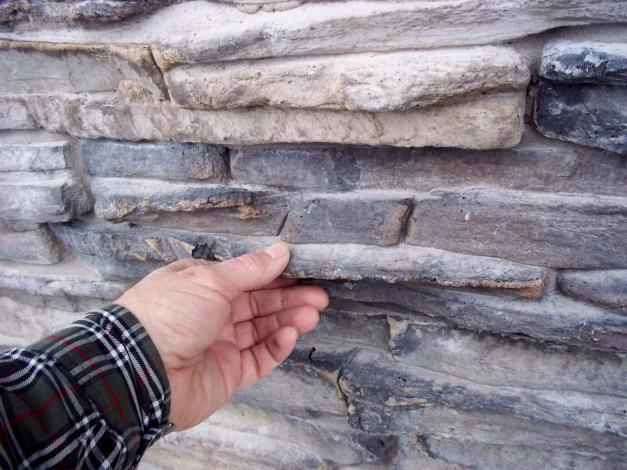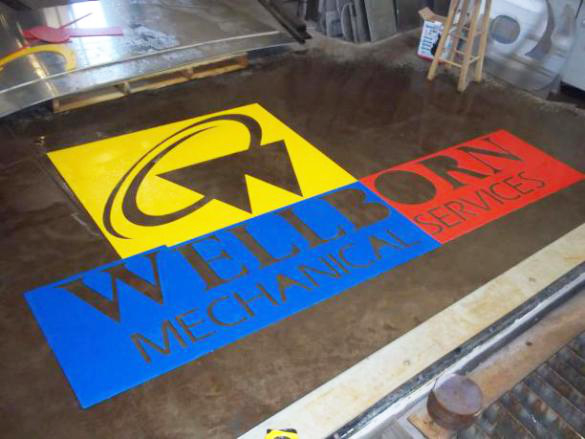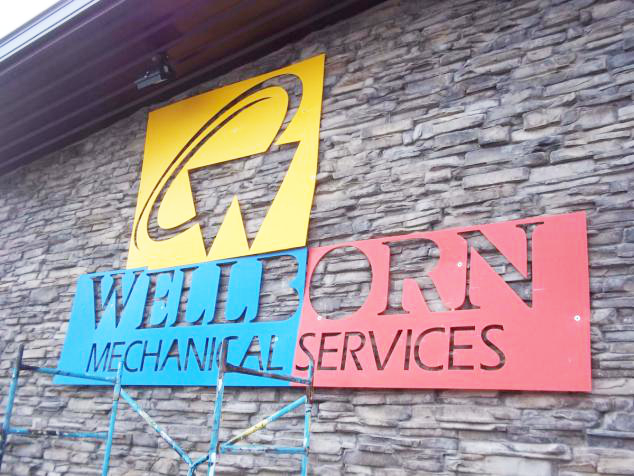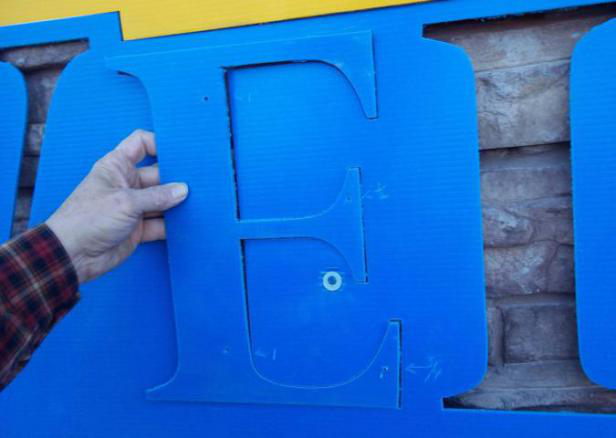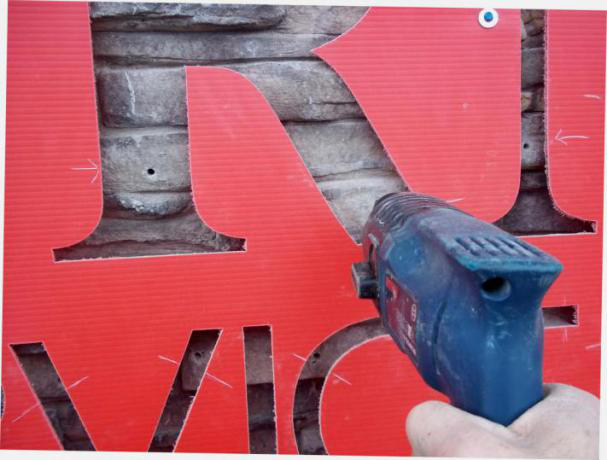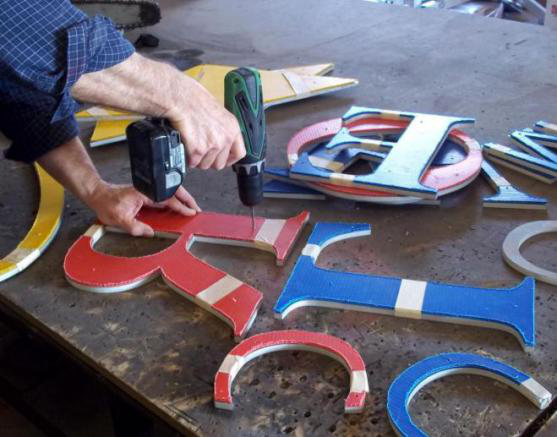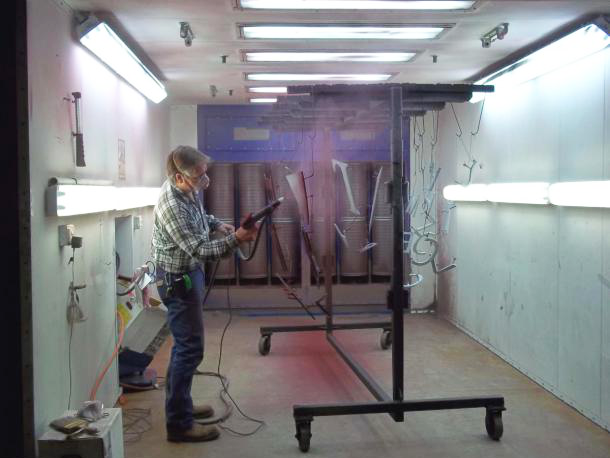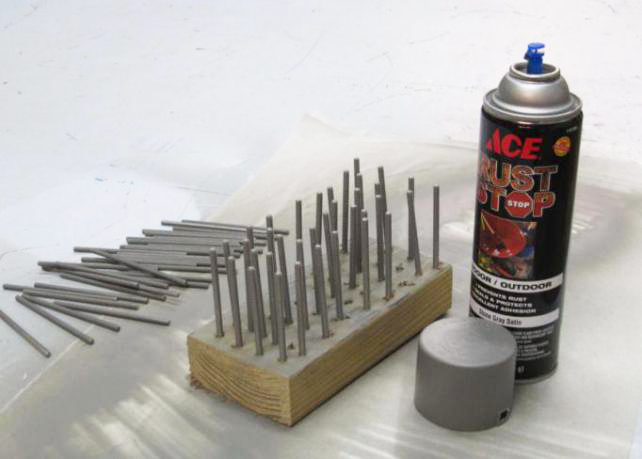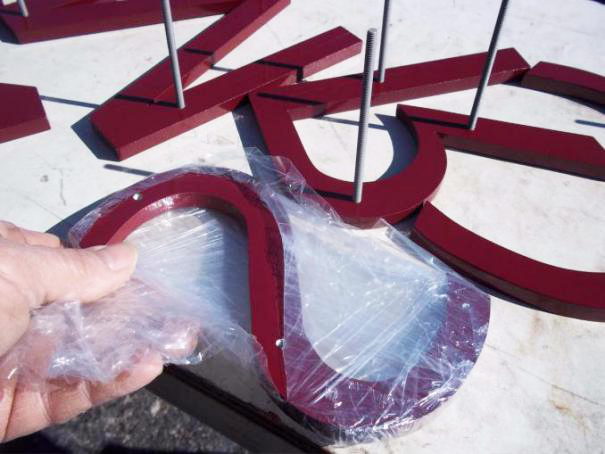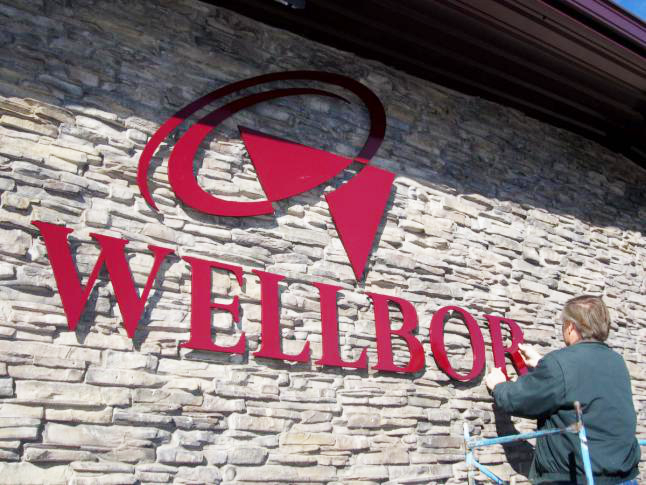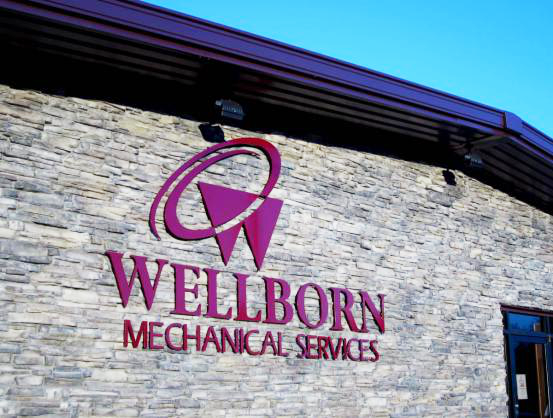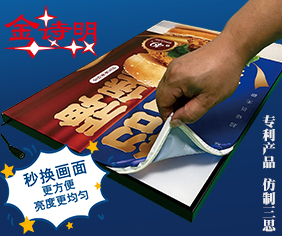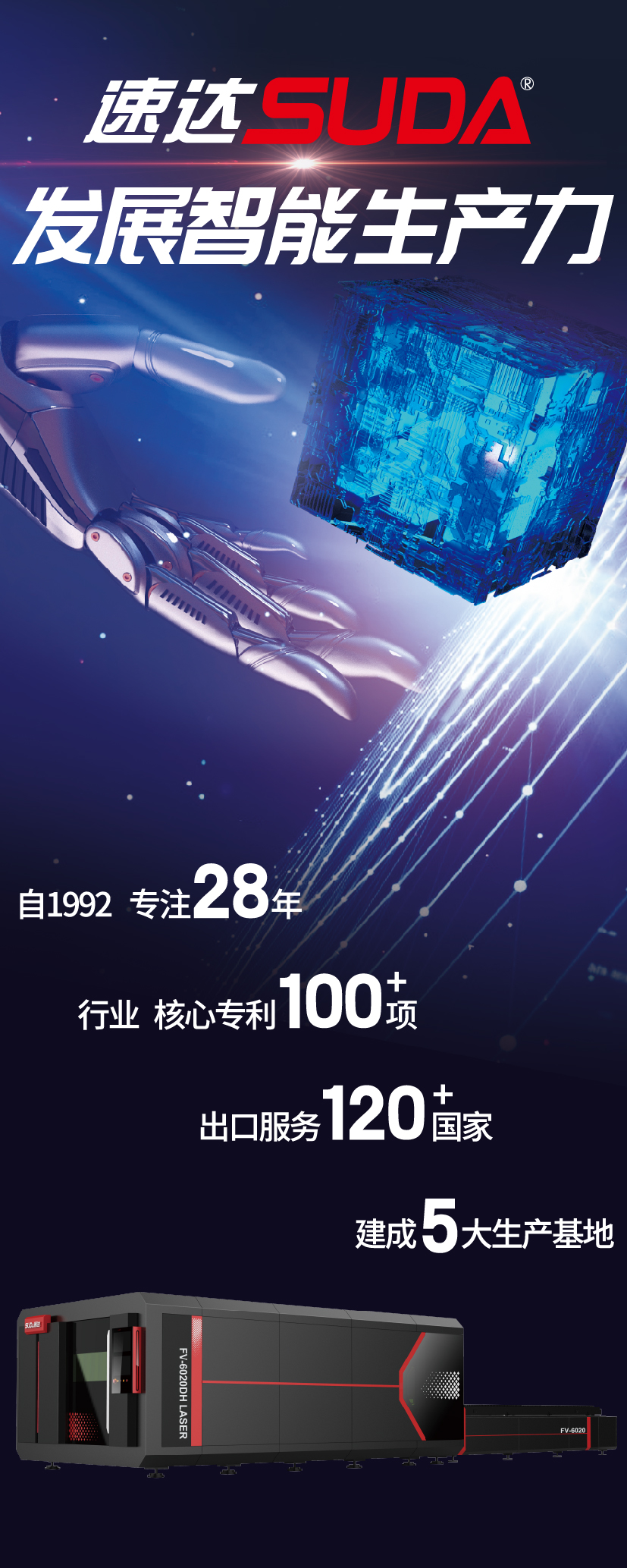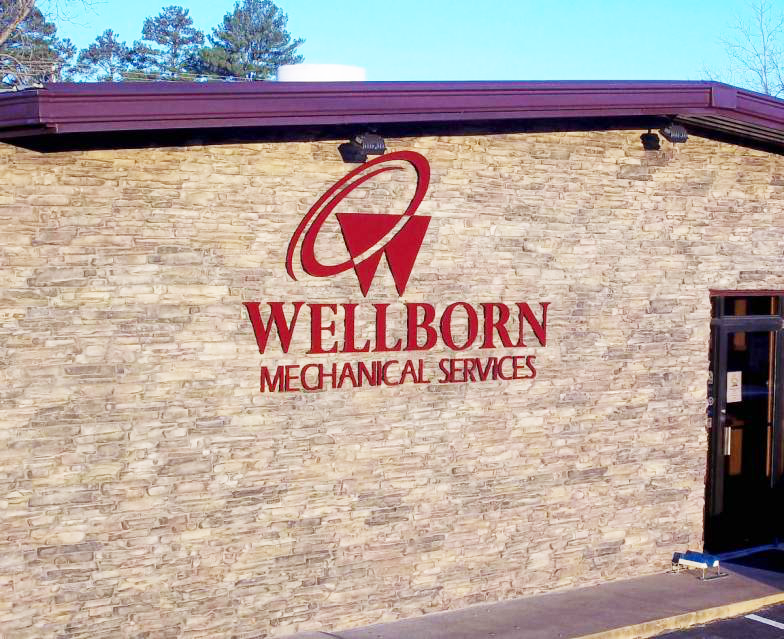
Every year we sell and install a number of plate metal letter and logo jobs, and in the past two or three years we’ve been able to do the manufacturing ourselves as well. Before this, we would order a turnkey set from a major manufacturer or work with local CNC cutting vendors and powder coaters.
每年,我们都会出售或安装一系列标识的工作,直到过去的两三年里,我们也开始自己生产和制作标识。在此之前,我们是需要从一家大型标识制造商那订购产品,再与当地的数控切割商和粉末涂装商进行合作,从而为我们的客户提供服务。
Nationally, a number of manufacturers make plate metal letters and logos, anodized or powder coated, and virtually all of these types of jobs are installed via threaded studs and typical stud patterns. Jobs like these can be ordered with stud patterns included, or a sign maker can make his own patterns, which I always do, so the spacing of each element can be exactly how we want them, not how some technician at a manufacturer saw it.
镀金标识和粉末涂层的工作,是需要通过典型的螺柱模式进行安装才能完成。实际上,产品可以从其他制造商那里订购,也可以自己做,但要使每个元素的间距达到自己想要的程度,就不能单单依赖标识制造商的一些技术人员。
Usually the patterns are made with no regard to exactly what type of brick, stucco or stone wall they will be installed on. The sign maker takes on the task of making the stud pattern, however it was done, work on the wall at hand.
通常情况下,图案的制作不完全需要先考虑是在哪种类型的外墙上进行安装。标识制造商只需要负责制作立柱图案,完成后,找对方式,在外墙上进行安装即可。
Recently we were given a chance to bid on a fairly large job of making and installing a company’s logo and lettering, cut in 3/8” thick aluminum, powder coated Texas A&M maroon (the owner of the establishment is a proud “Aggie”), but the rock wall they were to go on was nothing typical. In fact, it was man-made rock, which is a specially shaped and colored concrete product, in this case formed in such a way as to make a very rugged wall. There were many stones laid on edge, and the wall was littered with very pronounced protrusions of some of the rocks.
最近,我们有机会竞标,在一家公司的外墙墙幕上来安装标识,这家公司的外墙是一种特殊形状和颜色的混凝土制品,在这种情况下,它被制成非常坚固的墙壁,边上有许多石头,墙上堆满了一些突出的岩石,因此,这将是一个难度相当大的工程。我们需要裁剪3/8英寸厚的铝来制作一个栗色、带有Aggie字母的标识。
Man made rock is the most difficult type of wall to work with because it will certainly chip, and it usually shows chips worse than natural stone. And this wall was so unevenly set that it was going to matter exactly where each hole would be drilled. Holes at the edges of rocks would chip badly, so trying to hit each hole in strategic places would be a must. But how do you do that? Certainly not with the letters drilled and tapped in advance, using a stud pattern made with no consideration of where the holes would go in the wall.
在外墙墙幕上进行标识的安装工作是最困难的工作类型之一,因为它一定会碎裂,而且通常比天然石更容易碎,此外,这堵外墙的设置非常不均匀,以至于每个孔的钻孔位置都会发生变化,墙幕边缘的部分将会严重被损坏,因此,试图在准确位置击中每个洞是非常关键的。但我们需要怎么做呢?当然,我们绝对不是根据外墙墙幕上孔的位置去制作柱头图案的。
When I first went and visited the owner about this project, I failed to look at the wall’s surface seriously enough. Once I bid on it, and went back to get exact color choices and so forth, I looked more seriously at the project I had just gotten myself into and did not much like what I saw. Putting a paper pattern up on the wall first would do little good, since I could not see through it, so I thought about making an acetate or clear Mylar pattern. Though that would have worked better than paper, the more I thought about it the more I thought there was probably a better way.
当我们第一次去拜访业主的时候,没有足够认真地看待这堵墙的表面。一旦我们回去,进行颜色选择等工作时,才发现,一切并不是我们所看到的那样简单。所以,我们想先做一个醋酸酯或者透明的聚脂薄膜图案,才全面开展工作。
The final solution worked quite well, and accomplished the producing of a targeted hole pattern like none we’ve ever needed before. But, since these extra rugged walls are becoming popular these days, we will surely be doing this again and I thought I would share the solution with “Shop Talk” readers.
最终的解决方案得到了很好的应用,我们创新了一个目标洞的模式,但是,由于这些外墙墙幕现在变得越来越流行,应用的越来越多,我们需要把这次项目的解决方案分享给大家。
As shown by the accompanying photos, the final strategy was to cut a cheap corrugated plastic template that could be temporarily secured to the wall, complete with its removeable set of letters and logo parts. Cut like the real plate aluminum ones, this template could be used as a perfect guide to where each and every hole should be located and give us an easy way to mark the backs of the real letters and parts for drilling and tapping.
如附图所示,首先,我们的策略是,剪下一个波纹塑料模板,然后将模板暂时固定在外墙墙幕上,并将带有可拆卸的字母部分,像真正的铝板一样切割,这个模板对于每个孔的位置来说,像一个指南,作为一个简单的标记,来记下字母和零件的钻孔和攻丝的背面。
Using a waterjet as we did to cut the metal parts, we cut the plastic template in three easy-to-manage sections. Of course, we saved the large stencil or background parts, as well as all the letters that now fit in place with the small tolerance of the waterjet stream itself. Out on the job, the template was accurately screwed to the wall using a few small “tap-con” screws.
我们使用水刀来切割金属部件,将塑料模板切成三个易于管理的部分。值得注意的是,在此过程中,需要保存大型模板或背景的部分,以及所有适合水射流本身容差比较小的字母。接下来,我们还需要使用几个小的“tap-con”螺丝将模板精确地拧到外墙墙幕上。
With this done, it was easy to clearly see the best locations for each hole we needed to drill, and marks were made on the template to indicate this. One at a time, the letters were then placed into their respective places and marked where the studs would go, then taken out and holes were drilled in them with a small masonry bit. The letters were fit back in place and held while the same bit was used to drill through them just enough to mark “dots” on the wall itself.
通过这样做的目的是,让我们能够清楚地看到我们需要钻孔的最佳位置,并在模板上标记以表明这一点,再把这些字母放在各自的位置,并标出螺栓的位置,然后再取出,用小的石工钻头钻孔。最后再将标记好的字母放回原处,同时用相同的钻头穿透它们,在墙上用点标记好。
Then, before taking down our template and leaving the job, following the “dots” we had made on the rocks, all the holes needed for the install were drilled with a hammer drill using a ¼” bit masonry bit.
按照我们先前在外墙墙幕上所做的“点”,安装所需的所有孔都用一个1/4英寸的钻头钻出来。
Though we had to produce these plastic templates, the cost in material and waterjet cutting was less than $150 and this step eliminated the need for patterns at all. Next time we have a similar job we will have the templates cut from corrugated plastic when the letters themselves are being made. With this type of template, every single hole was easily placed in the best possible location. No holes were placed at edges of rocks, and no rocks were cracked or chipped even after drilling 200 holes or so. Success!
虽然这些塑料模板是我们必须要生产的,但在材料和水射流切割方面的成本还不到150美元,因为这一步骤根本不需要绘制图案。有了这种类型的模板,每个单孔很容易地放置在最佳的位置,即使在钻孔200下后,外墙墙幕的边缘也没有出现开裂或剥落。
Back at the shop, an assistant was assigned the task of taping the corrugated plastic letters and logo parts placed face down on the backs of the real 3/8” thick aluminum parts, and a small bit was used to drill shallow marking holes in each part by drilling through the small holes we had made in plastic template letters and logo sections in the field.
回到公司后,我们将正面朝下的塑料标识部件贴在厚铝件3 / 8的背面位置,在每个部分,我们用一个小钻头来钻孔标记,到此,我们已经作出塑料标识模板部分了。
Since the tapping had to be done almost last, it was going to be up to the sign maker to tackle this chore. We are fortunate to have a Flex Arm tapping machine, and we used it together with a basic shop drill press to get this part of the job done without spending too much time on it. The tapping could certainly have been done by hand, and we have done sets of letters this way many times before. But, having the right machine for the job is a plus.
我们很幸运地拥有一台Flex Arm攻丝机,我们将它与一台基本的钻孔机一起使用,完成了这部分工作,没有花费太多时间。其余部分是手工完成,而且反复做了很多次。
When finished with all the drilling and tapping, each hole was filled with a 3/16th diameter eye screw and then all the letters and logo parts were very lightly sandblasted on all surfaces. Some of the small eye screws were to be used to hang up the parts for powder coating, and some were merely there to protect the threads in each hole.
当完成所有的钻孔和攻丝后,我们在每个孔都填充了一个3/16直径的眼螺钉,然后将所有字母的表面上轻轻喷砂,一些小螺丝被用来挂粉末涂料的零件,保护每个孔的螺纹。
The job filled one large and one small powder coating rack, and the parts were coating with a beautiful deep maroon, to be exact RAL 3005, in a high gloss Tiger Drylac polyester powder. If you sometimes work with powder coaters and need a deep true burgundy or maroon, not too red or purple, this color, which is listed on any RAL Powder Coating color chart, is a good one. (RAL colors to powder coaters are like PMS colors to printers).
这项工作应用了一个大的和一个小的粉末涂装机,涂装出了一个美丽的深栗色标识。如果您有时使用粉末涂装机,需要深红或深紫红色这类颜色,那么,在RAL粉末涂布的颜色表中是一个不错的选择。(RAL颜色到粉末涂布机就像PMS颜色到打印机)
In the end, the installation of this set of letters and logos on a problematic rock wall, was simpler than most stud mounting jobs we’ve ever done. Once the powder coating was finished, we were ready for the final trip to the job site. This trip did not require drilling any holes, taping any patterns, or even taking a single measurement. All of that work was done in advance, and after using a small air compressor to blow out the dust from the holes, silicone sealant/adhesive was used as typical to secure each element in place.
最后,在外墙墙幕上进行安装工作,其实比我们所做的大部分螺柱安装工作都要简单。一旦粉末涂料完成,我们将准备好最后一趟去工作现场。而这次,我们不需要钻洞,也不需要敲打任何图案,只需要进行一次测量。另外,值得注意的是,小型空气压缩机将孔中的灰尘吹出来之后,还要使用硅酮密封粘合剂来将每个元件固定到位。
The studs, some of which would visually show in this rugged wall, had been painted a color that blended with the rocks. This step is often forgotten by sign makers, or they paint the studs to match the letters, which is a mistake. The studs need to be as invisible as possible, especially on rough walls that tend to expose them more than usual.
此外,当大部分安装工作完成之后,在这个崎岖的外墙墙幕上仍可以看到一些螺柱,与岩石的颜色相混合。标识制造商经常会忘记这个步骤,没有清理掉他们画出的螺柱,这是非常大的失误,钉子需要尽可能地被隐蔽起来,特别是在粗糙的外墙墙幕上,因为在粗糙的外墙上更容易暴露它们的存在。
There may be a better way for doing a tough install like this, but I don’t know of it. This throw away stencil strategy worked so well it turned an install wanting to be a disaster into another day at the office. And that’s exactly what we wanted. If you find yourself facing this type of annoying and difficult install, this method may be the easiest way to solve the problem, guaranteed to take some of the stress and frustration out of your life. And that, I’m sure you’ll agree, is always a good thing.
我们应用这种模具的策略非常有效,这也正是我们想要的。如果你发现自己面临着一种烦人又困难的安装方式时,这种方法可能为你带来一种新的解决思路,减少生活中的压力和挫折感,这些是我们的经验,希望能帮助到你。
